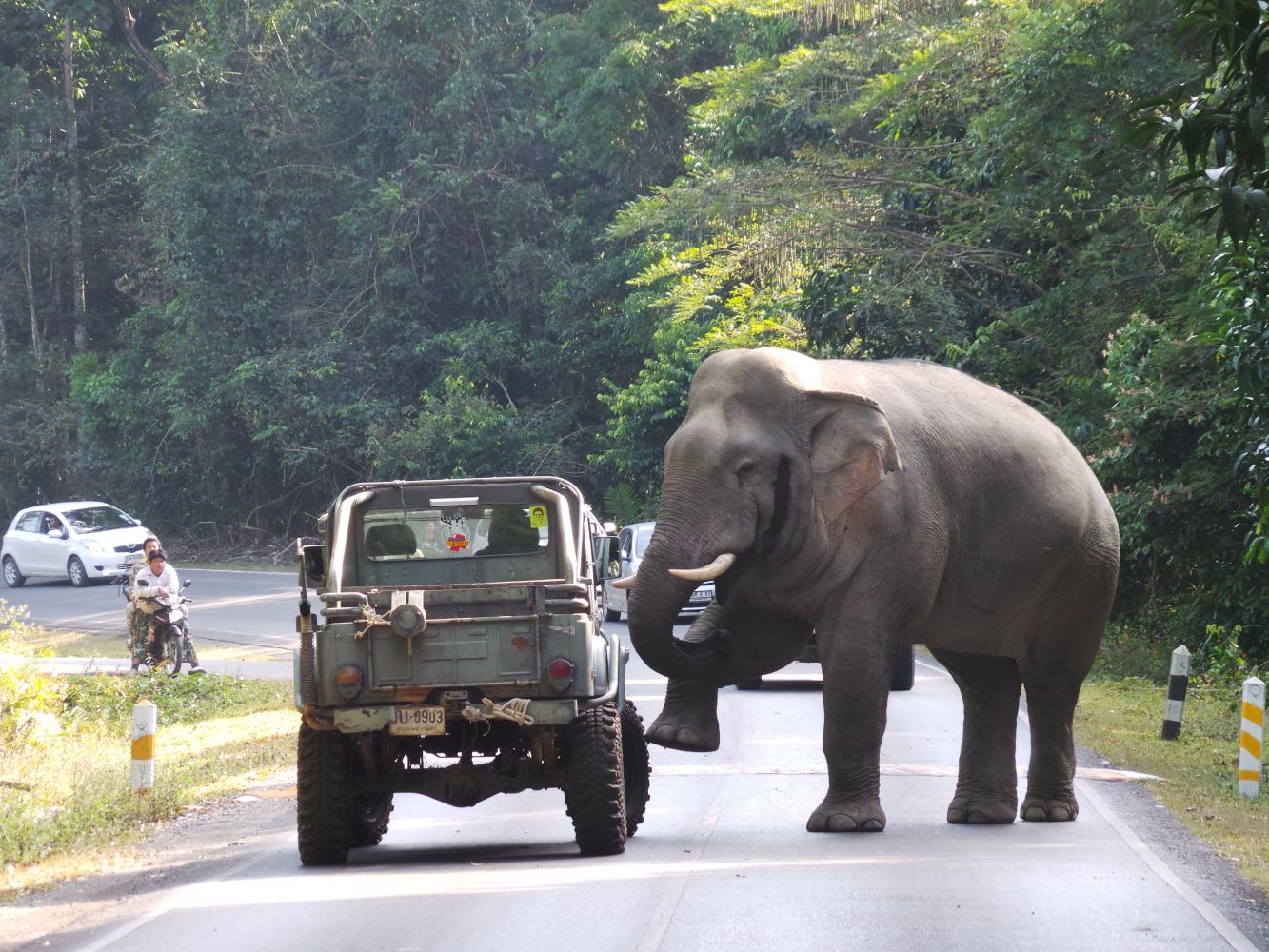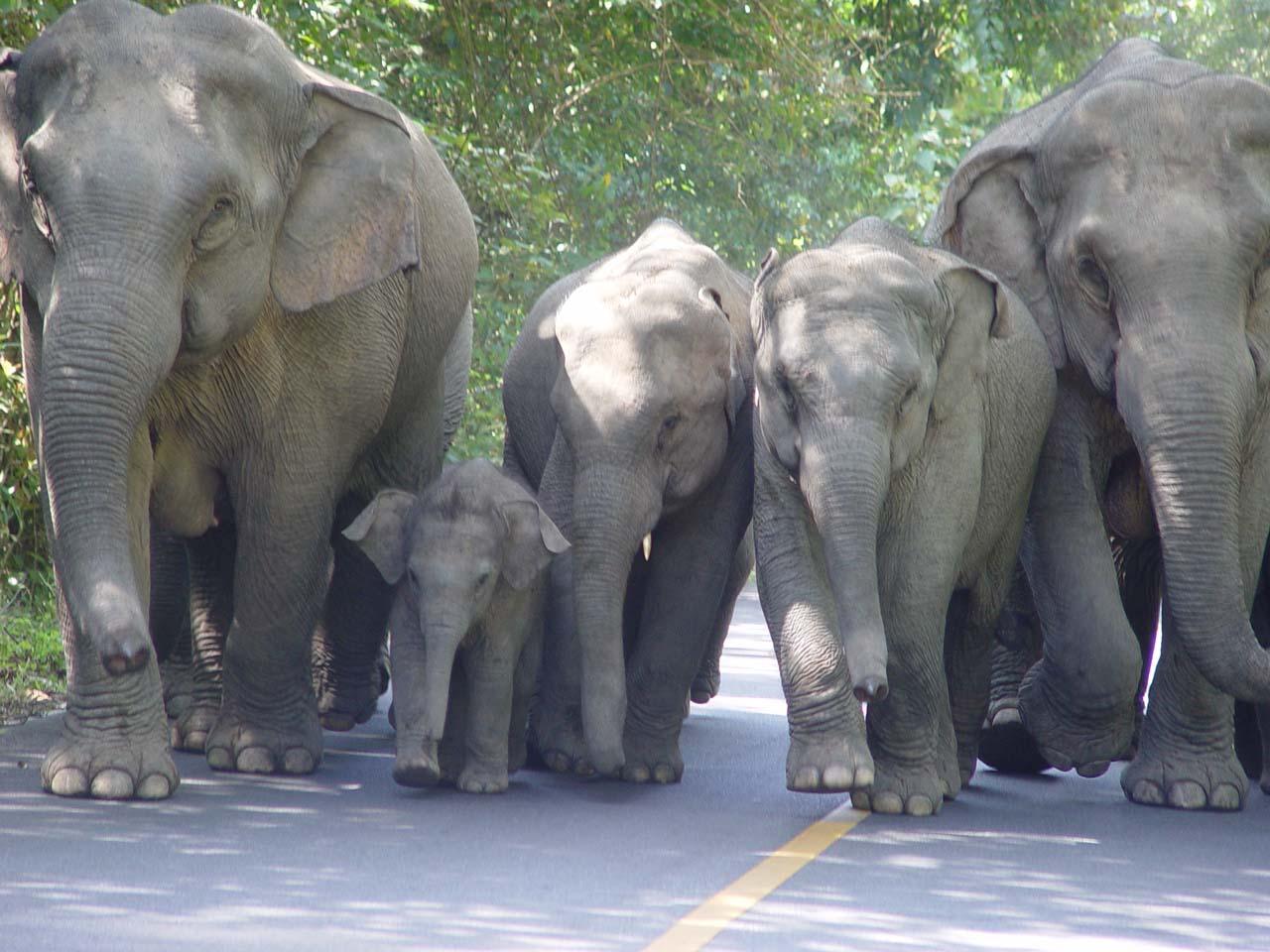Established as the country's first national park, Khao Yai National Park is known as one of the top tourist destinations in Thailand. It is also the first field classroom for many people, especially children.
On average, the park welcomes more than a million people per year and it is the third top national park destination in terms of total tourist numbers with 1.55 million tourists visiting the preserved area last year. The top two national parks were Khao Laem Ya-Koh Samet National Park in Rayong -- 1.6 million visitors -- and Tham Luang Khun Nam Nang Non Forest Park in Chiang Rai -- 1.7 million visitors, according to the Department of National Parks, Wildlife and Plant Conservation.
The peak month for tourists was in December when 294,233 people visited the park for a one-day trip or for overnight camping. On average, the park welcomed almost 9,500 people each day during peak season. However, in the quiet month of May, only 72,457 visited the park -- about 2,300 visitors per day.
In 2019, Khao Yai National Park also ranked fifth in terms of revenue as it generated 118 million baht, up 7% from 110 million baht the previous year. The top-earning park, however, was Noppharat Thara-Mu Koh Phi Phi in Krabi (374 million baht), followed by Mu Koh Similan National Park in Phangnga (327 million baht), Ao Phangnga National Park (272 million baht) and Khao Laem Ya-Mu Koh Samet in Rayong (247 million baht).



Wild animals have been seen in the open during the lockdown period. Clockwise from above, a herd of elephants at Nong Phak Chi, a serow taking a rest at Dieo Dai Cliff, and an oriental pied hornbill or nok kaek, the smallest of the four hornbill species found in Khao Yai, eating a reptile.

A white-handed gibbon feeds on wild fruit at Mo Singto. The gibbon is a small ape with white fur on the upper sides of its hands and feet. It is an endangered species. (Photo by Kulpat Saralamba)
However, this year, the revenue and the total number of tourists is expected to drop due to the closure of national parks nationwide amid the Covid-19 outbreak. Since March 25, tourists have been banned from entering Khao Yai National Park, the first time in its 58-year history. Sections of roads that pass through the park including Thanarat Road (Road 2090) from Pak Chong in Nakhon Ratchasima and Road 3077 from Prachin Buri have been blocked for traffic.
According to the national park chief Narin Pinsakul, the shutdown has provided more benefit than loss because it has given nature a chance to rest and recover.
In the past month, rangers have spotted more wild animals while patrolling the forest. They have seen dhole, serow, barking deer, smooth-coated otters, Malayan porcupines and silver pheasants to name a few. Four types of hornbills have also been spotted -- great hornbills, wreathed hornbills, white-throated brown hornbills and oriental pied hornbills.
The absence of tourist activities has given nature a break, Narin noted.
The national park spans an area of 2,168km² or about 1.3 million rai covering four provinces including Nakhon Nayok, Prachin Buri, Nakhon Ratchasima and Saraburi. Meanwhile, water sources in the protected forest land flow to five rivers including Nakhon Nayok River, Prachin Buri River, Lam Takhong River, Muak Lek River and Mun Liver.
The idea to establish the preserved forest area was initiated in 1958 by Dr Boonsong Lekhakul, the late pioneer of nature and wildlife conservation in Thailand. The project received a green light from the government of Field Marshal Sarit Thanarat and the park was established on Sept 18, 1962.
At present, Khao Yai National Park is home to 340 species of birds, and more than 70 mammal species, including about 300 wild elephants, gaurs and white handed-gibbons. About 50 reptile and amphibian species also live among the hundreds of varieties of trees and plants. The park was listed in the Dong Phayayen-Khao Yai Forest Complex together with four other protected forest areas, including Thap Lan National Park, Pang Sida National Park, Ta Phraya National Park, and Dong Yai Wildlife Sanctuary, as a World Heritage Site in 2005.


Namtok Haew Suwat is a famous attraction in the park. To reach the falls, it requires only a 100m walk from the car park. From the waterfall, there is another 3km trail leading to a viewpoint. A couple of years ago, a crocodile was spotted around Huai Lam Takhong off the natural study trail in the Haew Suwat waterfall area, leading to the closure of the area. Before the park was closed this year, visitors had not spotted the crocodile.


Located on the northeastern border of Khao Yai National Park, the Khao Phaeng Ma non-hunting area in Wang Nam Khieo district in Nakhon Ratchasima is a popular place for tourists to spot herds of gaur. The best time to observe the animal is during the morning and late afternoon when they come out to forage in the hilly grassland. (Photos by Krit Phromsakla Na Sakolnakorn & Nattapol Lovakij)
Over the decades, Khao Yai served as a giant classroom for well-known conservationists including Dr Pilai Poonswad, the prominent biologist who has been researching hornbills for about 40 years. Khao Yai National Park was the first place where she saw hornbills in 1965 and fell in love with it ever since.
She once talked with Life about her first experience while exploring the dense forest of Khao Yai with the late Dr H Elliott McClure, an eminent scientist and also her mentor, for his Migratory Animal Pathological Survey project. She heard a sound like a whirring helicopter before seeing a great hornbill flying above her head. The impression of the majestic bird encouraged her to study them more and led to a conservation programme. In 1978, she founded the Thailand Hornbill Project. It was later upgraded to the Hornbill Research Foundation, which has been in operation until today. For Dr Pilai, Khao Yai is her second home.
The forest, which is rich in flora and fauna, attracts not only bird watchers but also amateur and professional photographers as well as campers. Trekking into the woods is also good exercise and a recreational activity for many tourists. Khao Yai also provides visitors with a chance to absorb the beauty of nature.
Those who love serenity try to avoid visiting the park during weekends and long holidays because it is overcrowded. Attractions will be full of visitors and noisy people, which reduces the opportunity to see birds or other wild animals.
After a month of closure, tourists have started to ask when the park will reopen again while some others want the park to remain closed at least for a month or two every year from now on. The answer has not yet been revealed and may not be until the Covid-19 outbreak is under control. During this time, those who love Khao Yai National Park can visit its Facebook fan page at KhaoYaiNationalPark1962.


Feeding wildlife is illegal but some visitors ignore the law and offer food to monkeys. Such monkeys can be found sitting along the side of Road 3077 from Prachin Buri. The feeding causes accidents which sometimes lead to the death of monkeys. The fine for feeding wildlife is too low at only 500 baht. (Photos by Pattarapong Chatpattarasill)


Sambar deer seem to be familiar with people. They walk freely around the Tourist Information Centre and canteen searching for food. During one fine evening a couple of months ago while my friends and I had dinner in the canteen, we also spotted porcupines running around looking for food crumbs on the floor. (Photo by Karnjana Karnjanatawe & Patipat Janthong)


A viewpoint at Pha Dieo Dai cliff offers a panoramic view of the forest area of Khao Yai. Pha Dieo Dai has a natural-study trial which is easy to negotiate. It will take roughly about 30 minutes to complete the loop. (Photos by Karnjana Karnjanatawe)


The forest area of Mo Singto in the national park is home to white-handed gibbons. Those who want to see the animal in its habitat must ask for permission and also have a ranger as a guide. The trail is a bit challenging for those who are not physically fit. Along the trail, visitors can spot flowers, mushrooms, vines and birds. (Photos courtesy of The National Science and Technology Development Agency)


Visitors sometimes find elephants or a herd of jumbos walking along Road 3077 leading to the gate of the national park. I once saw two elephants eating bamboo along the road while another time I saw a small herd of elephants at a salt lick not far from the roadside. Most of the time, rangers will show up with their vehicles to prevent any accidents that might happen to visitors or the elephants but some unexpected things can happen like an elephant rubbing itself against a car. (Photo by Alongkot Chukaew & Intarachai Panichakul)

